Summary of climate disasters on the planet: March 19–25, 2025
The largest wildfires in South Korea’s history are raging across the country. In Portugal, storm-force winds overturned airplanes at an airfield. In Russia, within just two days, Kamchatka was buried in snow, while summer-like warmth unexpectedly arrived in Siberia in March.
However, the greatest concern is the activation of the Siberian Plume — a massive stream of magma rising from the Earth's interior.
Read about all this in the summary of climate disasters that occurred during the week of March 19–25, 2025.
South Korea
A state of emergency was declared in three regions of South Korea — the city of Ulsan, and the provinces of North Gyeongsang and South Gyeongsang. This marks the 5th such case in South Korea’s history. The country is facing some of the most extensive wildfires it has ever experienced.
Starting on March 21, the fire spread across more than 38,600 hectares (95,400 acres) in just one week. As of March 27, the wildfires have claimed 28 lives and injured 32 people.
The disaster damaged or destroyed at least 2,600 residential homes, as well as factories, warehouses, and numerous outbuildings.
Flames approached several settlements. According to eyewitnesses, entire villages burned to the ground. The number of evacuees reached nearly 38,000 people.
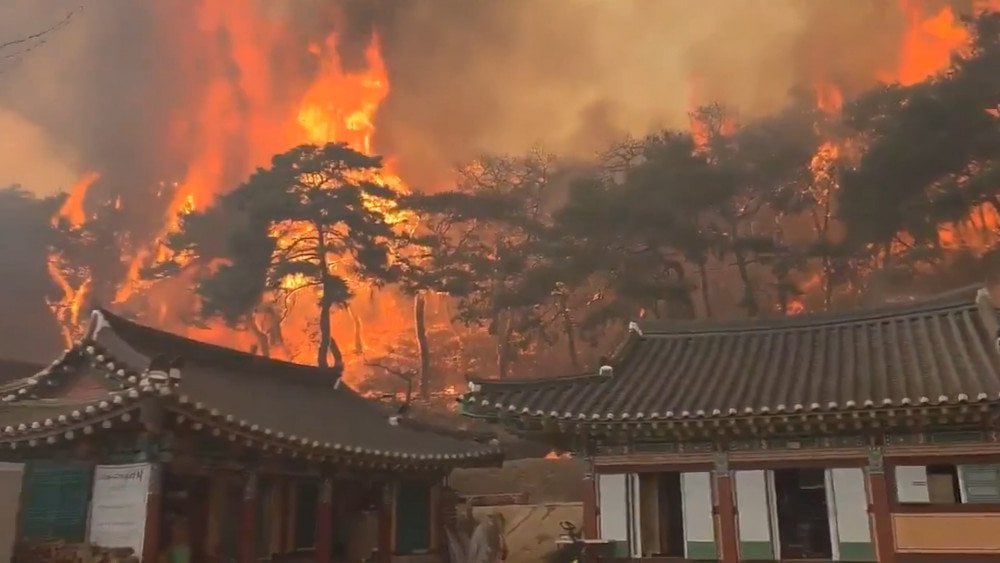
Uncontrolled wildfire devours everything in its path, South Korea
Pets and livestock had to be released into the streets in order to survive. Many wild animals were hit by vehicles as they fled in panic from the raging disaster.
In North Gyeongsang Province, the Korea Railroad Corporation temporarily suspended train service between Uiseong and Andong stations.
Traffic on the Busan–Ulsan expressway was shut down.
A total of 9,200 firefighters and rescue workers, along with 105 helicopters, were deployed to battle the flames. However, despite the massive deployment of resources, the fires remain uncontained, worsened by strong winds and dry weather.
Storm Martinho
On March 19 and 20, a powerful storm named Martinho struck Portugal, bringing torrential rains and hurricane-force winds reaching speeds of 33.5 m/s (120.6 km/h or 74.9 mph).
The Greater Lisbon metropolitan area was hit the hardest, where at least 8 people were injured.
In the municipality of Odivelas, wind gusts damaged the roof of a local elementary school. Traffic was temporarily halted on the bridge over the Tagus River, which connects the cities of Lisbon and Almada. In addition, at an airfield in the city of Cascais, strong winds overturned several small airplanes.

Storm wind flips a small plane, Cascais, Portugal
The next day, on March 21, Martinho moved into Spain. In the central and southern parts of the country, heavy downpours caused a rapid rise in river water levels.
In the city of Águilas, 70 mm (2.75 in) of rainfall fell in just one hour. The grounds of the San Juan de las Águilas school were completely flooded within minutes. To protect the children from rising water, it intrusion, and potential roof collapse, they were moved to the second floor of the building.
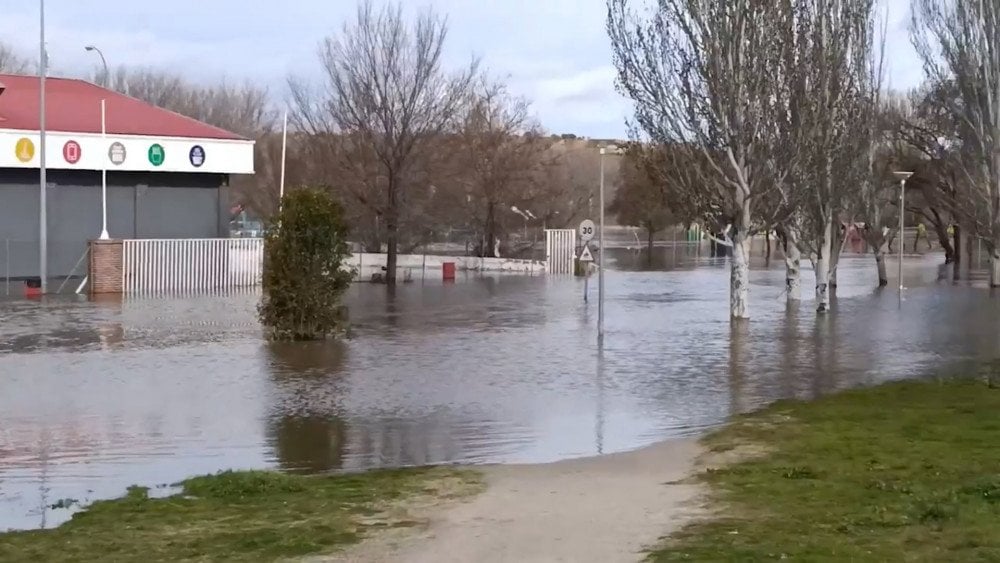
Sudden flood caused by storm Martinho, Spain
Meanwhile in Madrid, due to continuous rainfall, March 2025 became the wettest month ever recorded in the city’s meteorological history.
Malaysia
Since March 19, intense and unrelenting rainfall has hit the southern state of Johor in Malaysia. According to the State Disaster Management Committee, water levels in rivers across six districts rose above the danger mark, triggering flash floods. Some roads were closed to all traffic due to powerful water flow, and two bridges were damaged.
In the center of Johor Bahru — Malaysia’s second-largest city — massive traffic jams formed. In Kampung Pasir Tebrau, water rose so high that only rooftops were visible above the flood. Some victims stated that this was the worst flood they had ever experienced.
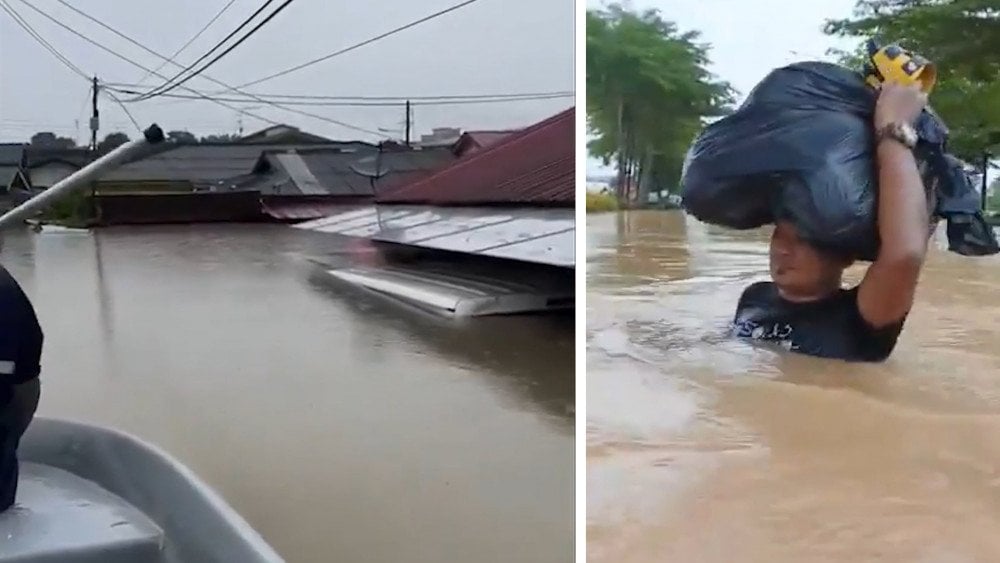
Catastrophic flood in Malaysia
A total of 13,089 people were evacuated from flooded homes and placed in 95 temporary evacuation centers.
Classes were suspended in 20 schools. Two schools were completely flooded.
According to one teacher, this is the first time her school experienced flooding on such a large scale —the water rose to the second floor.
Saudi Arabia
An extreme amount of precipitation hit Saudi Arabia starting March 19.
In the capital region of Riyadh, three months’ worth of rain fell over just three days. At King Khalid International Airport, 25.9 mm (1.02 in) of rain fell between March 21–23, compared to the March average of 7.4 mm (0.29 in).
Meanwhile, in the city of Jeddah, Makkah Region, at King Abdulaziz International Airport, 24 mm (0.94 in) of rain fell in just two days, March 20–21 — a volume typically seen over the course of an entire year (annual average: 24.7 mm / 0.97 in).
In the Asir Province, heavy rain was accompanied by large hailstones, covering mountain peaks and roads, and transforming the landscape into a winter-like scene.
The rainfall caused flooding in valleys and low-lying areas. Roads were inundated, leading to major transportation disruptions. Authorities in Saudi Arabia closed schools in several parts of the kingdom.

Heavy rain floods roads, Saudi Arabia
For a country with an arid climate, such disasters were once extremely rare. However, in recent years, they have begun to occur with alarming frequency.
Russia
Hundreds of air temperature records were broken in Siberia. On March 19, the city of Novosibirsk experienced its warmest day in the past 102 years. That day, temperatures rose to +8.7 °C (47.7 °F), while the average March high is −3 °C (26.6 °F). The previous record of +7.9 °C (46.2 °F) was set on March 19, 1923.
By the night of March 22, many residents were awakened by a loud noise — a thunderstorm accompanied by heavy snowfall. Such thundersnow is extremely unusual for this time of year in Western Siberia, where sub-zero temperatures typically persist. However, locals are no longer surprised — in recent years, unusual weather phenomena like this have become increasingly common.
On March 20, several of the warmest locations in Russia included localities in the Altai Republic, Krasnoyarsk Krai, Irkutsk Oblast, and Khakassia.
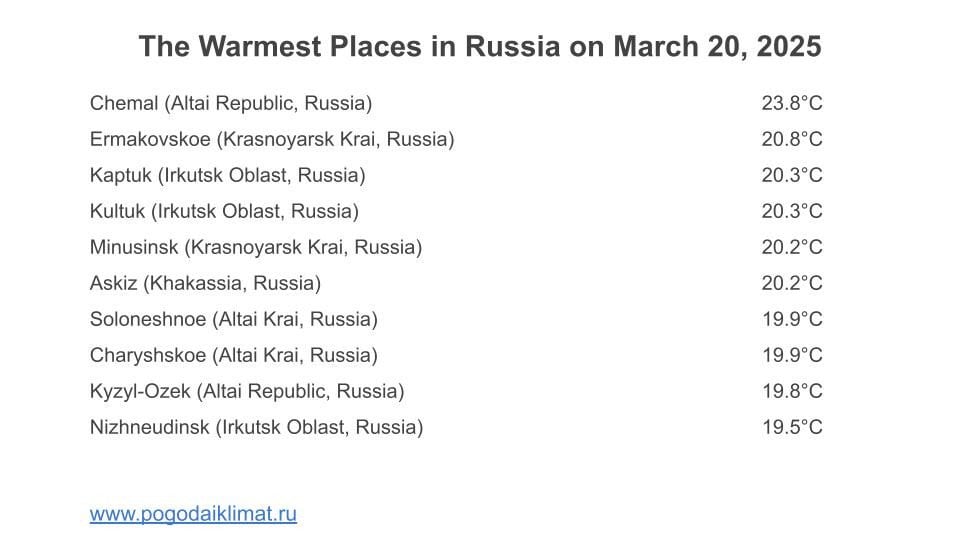
Temperature anomalies in Russia on March 20, 2025
In the village of Chemal, Altai Republic, daily temperature records were broken three days in a row — March 19, 20, and 21. On March 21, the air temperature soared to an unbelievable +24 °C (75.2 °F), while the average high for this period is only +1 °C (33.8 °F).
Even at night, many towns experienced summer-like warmth. In Krasnoyarsk, on March 21, the daytime temperature reached +16.3 °C (61.3 °F), and overnight it did not fall below +9.9 °C (49.8 °F). That is a full 22 degrees Celsius above the climate norm! The average nighttime low in Krasnoyarsk is typically −12 °C (10.4 °F).
In the village of Khorinsk, Republic of Buryatia, where the average nighttime temperature is usually −9 °C (15.8 °F), the low on March 20 rose to +7.5 °C (45.5 °F), and on March 21 — to +10.2 °C (50.4 °F).
From March 18 to 22, temperatures in the Republic of Buryatia and Irkutsk Oblast rose to +19 °C (66.2 °F), leading to rapid snowmelt. In Irkutsk, on March 21, the temperature reached +19.4 °C (66.9 °F), and in Ulan-Ude — +18.7 °C (65.7 °F). As a result, dozens of settlements were flooded.
In Chelyabinsk Oblast, the sudden warming caused an unexpectedly early ice breakup on the Sim and Gumbeika rivers.
In the town of Asha, ice jams caused a rapid rise in water levels, flooding 150 houses. The flood developed so quickly that many residents were unable to save their belongings or pets.

Sudden flood inundated streets and cars, Asha, Chelyabinsk Oblast, Russia
Around 170 people were evacuated from the flood zone, including children and people with disabilities. A state of emergency was declared in the city on March 18. Locals said they could not recall a flood of this scale ever happening before.
On March 23, a powerful snow cyclone hit Petropavlovsk-Kamchatsky. More than 82 cm (32.3 in) of snow fell in just two days — more than during the entire previous winter, according to the head of the municipal district.
Petropavlovsk-Kamchatsky was paralyzed: public transport was halted, roads were buried in snow, and drivers who ventured out became stuck on uncleared streets.

Heavy snowfall blocks vehicles in Petropavlovsk-Kamchatsky, Russia
An avalanche descended from a hillside in the city center, further complicating the situation. Due to the snowfall and gusty winds, flights were delayed. Authorities urged residents to stay home and asked business owners to shift employees to remote work.
In Primorsky Krai, two deep-focus earthquakes occurred within less than 24 hours. On March 23 at 22:02 LT, a magnitude 4.5 earthquake struck near the village of Novonezhino at a depth of 475 km (295 mi). On March 24 at 17:57 LT, a magnitude 4.4 earthquake occurred 145 km (90 mi) south of Cape Gamov, with the hypocenter located 560 km (348 mi) below the surface.
Due to their great depth, the seismic tremors were not felt by residents and caused no damage.
However, it is important to note that, as with the rest of the planet, Primorsky Krai is experiencing a noticeable increase in seismic activity clearly shown in recent graphs.
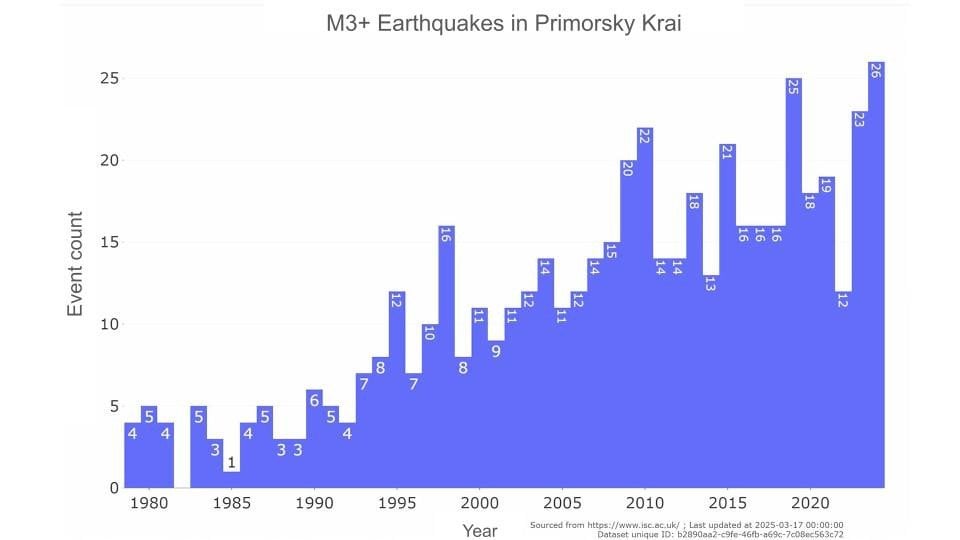
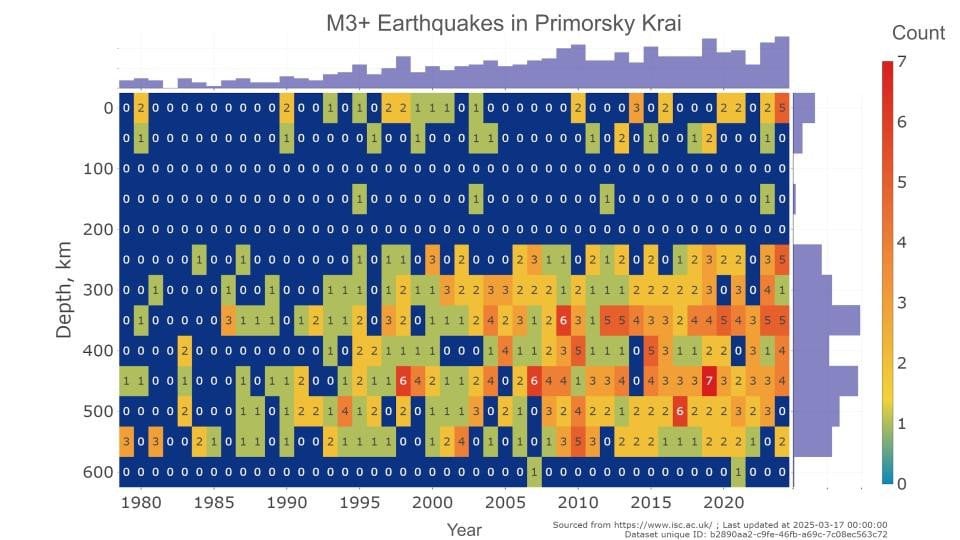
Chart and depth distribution of M3+ earthquakes in Primorsky Krai, Russia
If there are still people who doubt the increase in natural disasters, Siberians are not among them — they already feel it firsthand. Just read the local forums or comments under weather reports, and it becomes clear: these changes are unprecedented, even longtime residents say they’ve never seen anything like it.
The key news is that scientists have identified the causes of these anomalies. One of them is a massive magma plume rising from deep within the Earth beneath Siberia. It is now triggering natural anomalies not only in Siberia but also influencing the rise in global natural disasters.
To raise awareness, an international group of scientists, supported by volunteers, has prepared a report titled: “On the Threat of a Magma Plume Eruption in Siberia and Strategies for Addressing the Issue.”
We believe it is important to share this information not only with readers of this article, but with the global community. The report details alarming signs of plume activity: permafrost thawing, increased mud volcanism, soil heating, rising seismic activity, and more. It also proposes a concrete program for planned, controlled plume degassing as a way to prevent a potential catastrophe.
This report is not just a scientific study — it is a clear action plan. Its goal is to deliver critical information to governments, private organizations, the scientific community, and anyone ready to act to help address the accelerating rise in global natural disasters.
You can watch the video version of this article here:
Leave a comment